Brake GENESIS GV80 2021 Owner's Manual
[x] Cancel search | Manufacturer: GENESIS, Model Year: 2021, Model line: GV80, Model: GENESIS GV80 2021Pages: 632, PDF Size: 9.37 MB
Page 11 of 632
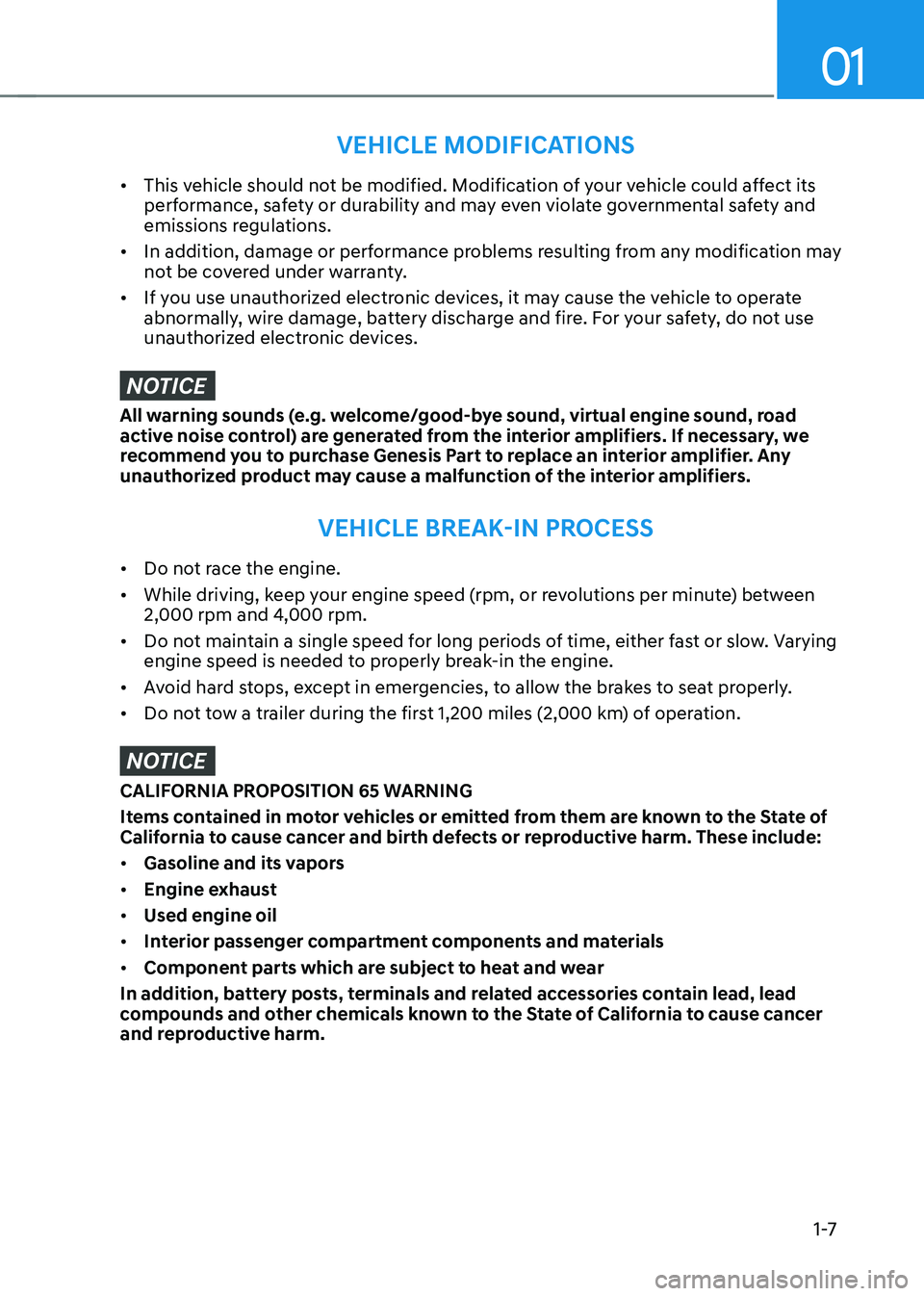
01
1 -7
VEHICLE MODIFICATIONS
• This vehicle should not be modified. Modification of your vehicle could affect its
performance, safety or durability and may even violate governmental safety and
emissions regulations.
• In addition, damage or performance problems resulting from any modification may
not be covered under warranty.
• If you use unauthorized electronic devices, it may cause the vehicle to operate
abnormally, wire damage, battery discharge and fire. For your safety, do not use
unauthorized electronic devices.
NOTICE
All warning sounds (e.g. welcome/good-bye sound, virtual engine sound, road
active noise control) are generated from the interior amplifiers. If necessary, we
recommend you to purchase Genesis Part to replace an interior amplifier. Any
unauthorized product may cause a malfunction of the interior amplifiers.
VEHICLE BREAK-IN PROCESS
• Do not race the engine.
• While driving, keep your engine speed (rpm, or revolutions per minute) between
2,000 rpm and 4,000 rpm.
• Do not maintain a single speed for long periods of time, either fast or slow. Varying
engine speed is needed to properly break-in the engine.
• Avoid hard stops, except in emergencies, to allow the brakes to seat properly.
• Do not tow a trailer during the first 1,200 miles (2,000 km) of operation.
NOTICE
CALIFORNIA PROPOSITION 65 WARNING
Items contained in motor vehicles or emitted from them are known to the State of
California to cause cancer and birth defects or reproductive harm. These include:
• Gasoline and its vapors
• Engine exhaust
• Used engine oil
• Interior passenger compartment components and materials
• Component parts which are subject to heat and wear
In addition, battery posts, terminals and related accessories contain lead, lead
compounds and other chemicals known to the State of California to cause cancer
and reproductive harm.
Page 12 of 632
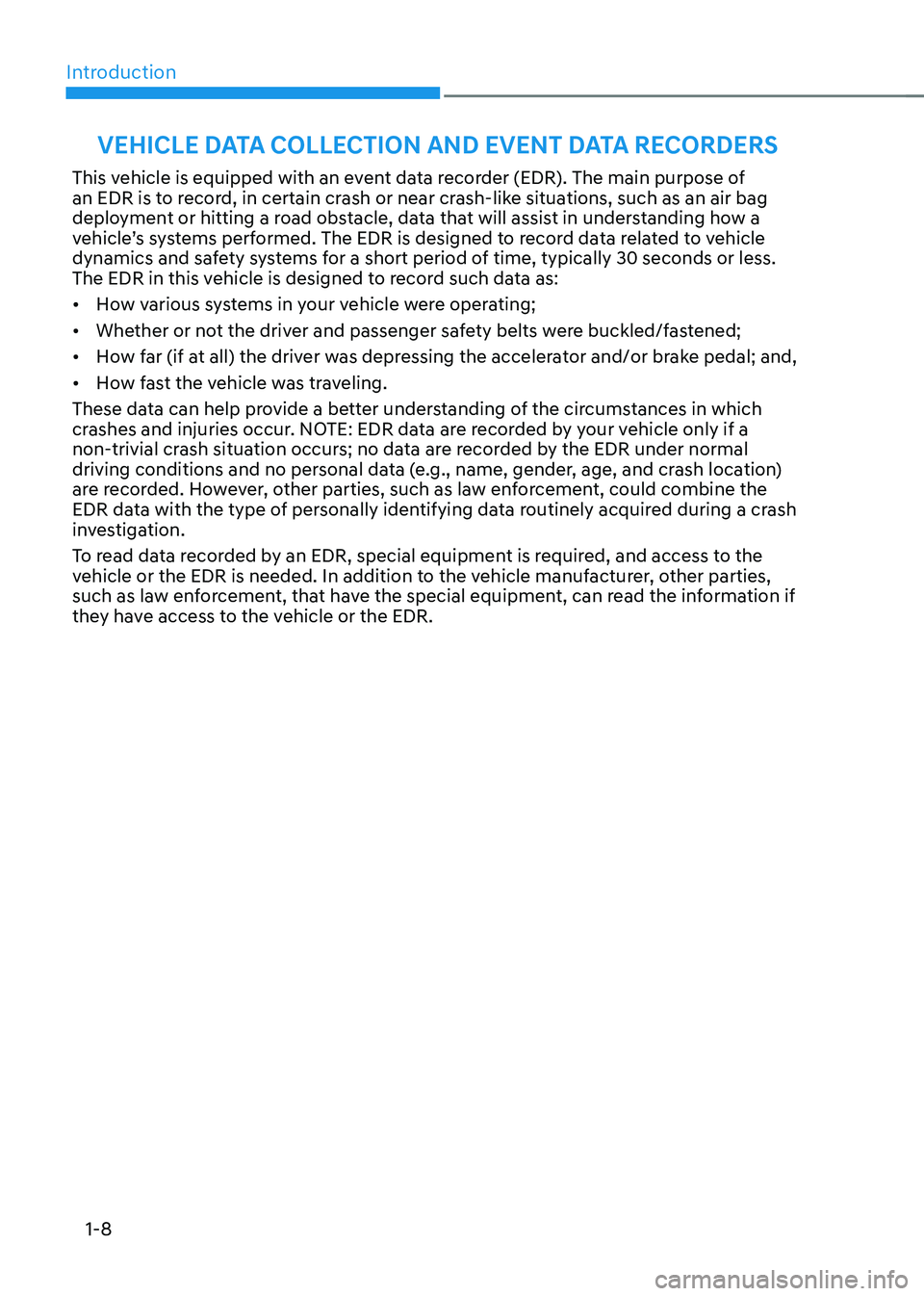
Introduction1-8
VEHICLE DATA COLLECTION AND EVENT DATA RECORDERS
This vehicle is equipped with an event data recorder (EDR). The main purpose of
an EDR is to record, in certain crash or near crash-like situations, such as an air bag
deployment or hitting a road obstacle, data that will assist in understanding how a
vehicle’s systems performed. The EDR is designed to record data related to vehicle
dynamics and safety systems for a short period of time, typically 30 seconds or less.
The EDR in this vehicle is designed to record such data as:
• How various systems in your vehicle were operating;
• Whether or not the driver and passenger safety belts were buckled/fastened;
• How far (if at all) the driver was depressing the accelerator and/or brake pedal; and,
• How fast the vehicle was traveling.
These data can help provide a better understanding of the circumstances in which
crashes and injuries occur. NOTE: EDR data are recorded by your vehicle only if a
non-trivial crash situation occurs; no data are recorded by the EDR under normal
driving conditions and no personal data (e.g., name, gender, age, and crash location)
are recorded. However, other parties, such as law enforcement, could combine the
EDR data with the type of personally identifying data routinely acquired during a crash
investigation.
To read data recorded by an EDR, special equipment is required, and access to the
vehicle or the EDR is needed. In addition to the vehicle manufacturer, other parties,
such as law enforcement, that have the special equipment, can read the information if
they have access to the vehicle or the EDR.
Page 16 of 632
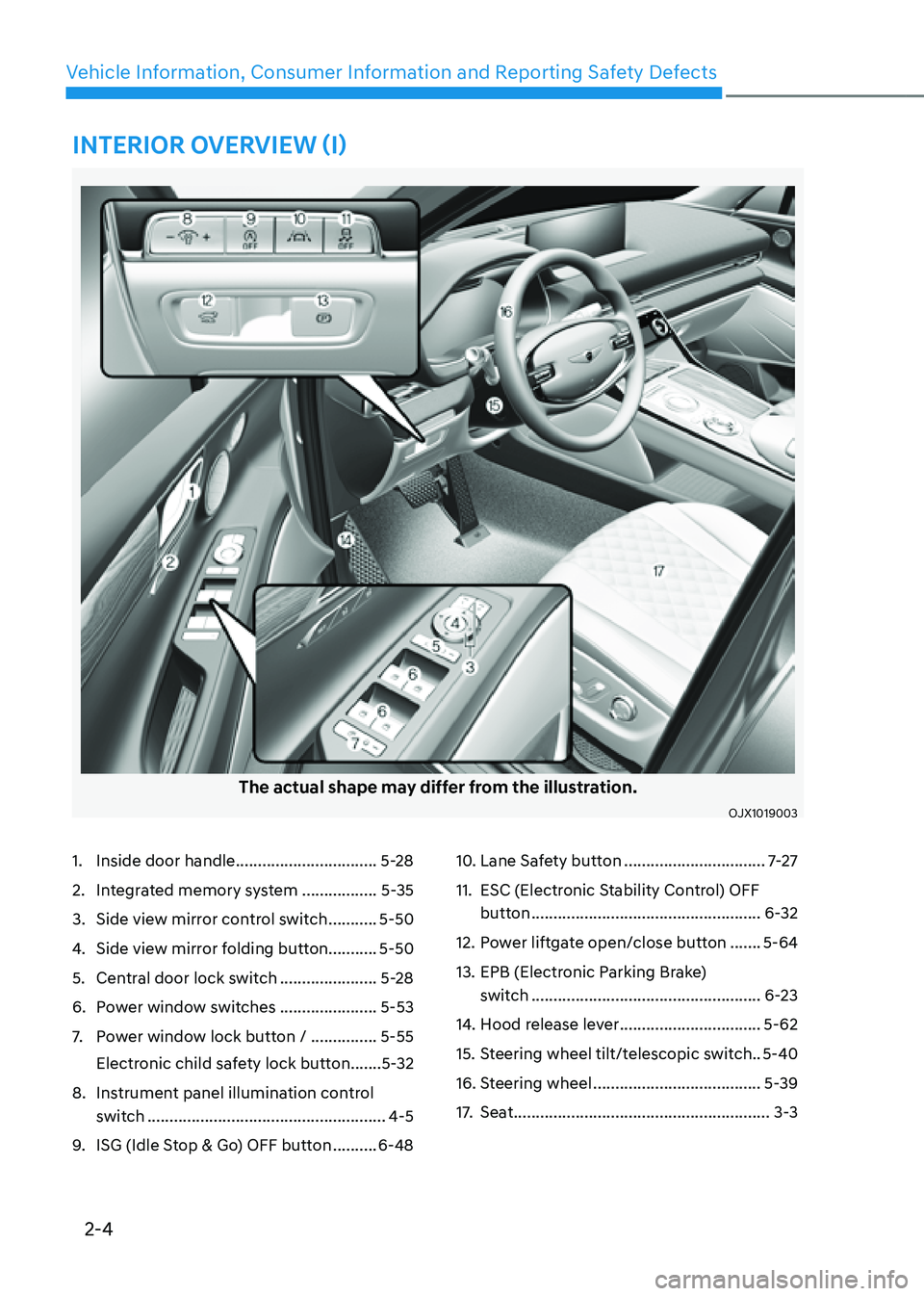
2-4
Vehicle Information, Consumer Information and Reporting Safety Defects
The actual shape may differ from the illustration.
OJX1019003OJX1019003
1. Inside door handle ................................5-28
2. Integrated memory system .................5-35
3. Side view mirror control switch ...........5-50
4. Side view mirror folding button...........5-50
5. Central door lock switch ......................5-28
6. Power window switches ......................5-53
7. Power window lock button / ...............5-55
Electronic child safety lock button
.......5-32
8. Instrument panel illumination control
switch
......................................................4-5
9. ISG (Idle Stop & Go) OFF button ..........6-48
10. Lane Safety button ................................7-27
11. ESC (Electronic Stability Control) OFF
button
....................................................6-32
12. Power liftgate open/close button .......5-64
13. EPB (Electronic Parking Brake)
switch
....................................................6-23
14. Hood release lever ................................5-62
15. Steering wheel tilt/telescopic switch ..5-40
16. Steering wheel ......................................5-39
17. Seat ..........................................................3-3
INTERIOR OVERVIEW (I)
Page 17 of 632
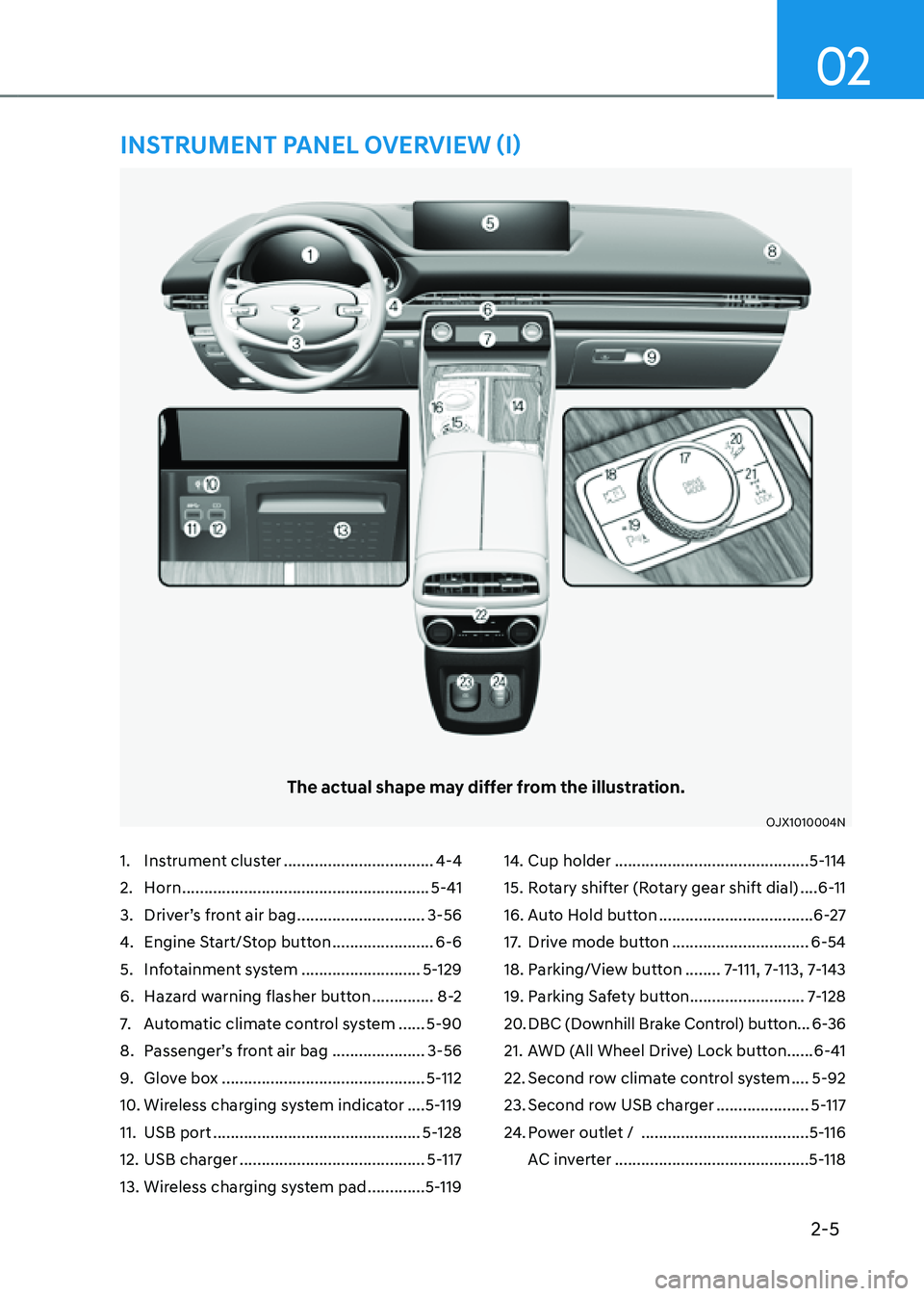
2-5
02
1. Instrument cluster ..................................4-4
2. Horn ........................................................5-41
3. Driver’s front air bag .............................3-56
4. Engine Start/Stop button .......................6-6
5. Infotainment system ...........................5-129
6. Hazard warning flasher button ..............8-2
7. Automatic climate control system ......5-90
8. Passenger’s front air bag .....................3-56
9. Glove box ..............................................5-112
10. Wireless charging system indicator ....5-119
11. USB port ...............................................5-128
12. USB charger ..........................................5-117
13. Wireless charging system pad .............5-119
14. Cup holder ............................................5-114
15. Rotary shifter (Rotary gear shift dial) ....6-11
16. Auto Hold button ...................................6-27
17. Drive mode button ...............................6-54
18. Parking/View button ........7-111, 7-113, 7-143
19. Parking Safety button ..........................7-128
20. DBC (Downhill Brake Control) button ...6-36
21. AWD (All Wheel Drive) Lock button ......6-41
22. Second row climate control system ....5-92
23. Second row USB charger .....................5-117
24. Power outlet / ......................................5-116
AC inverter
............................................5-118
The actual shape may differ from the illustration.
OJX1010004NOJX1010004N
INSTRUMENT PANEL OVERVIEW (I)
Page 19 of 632
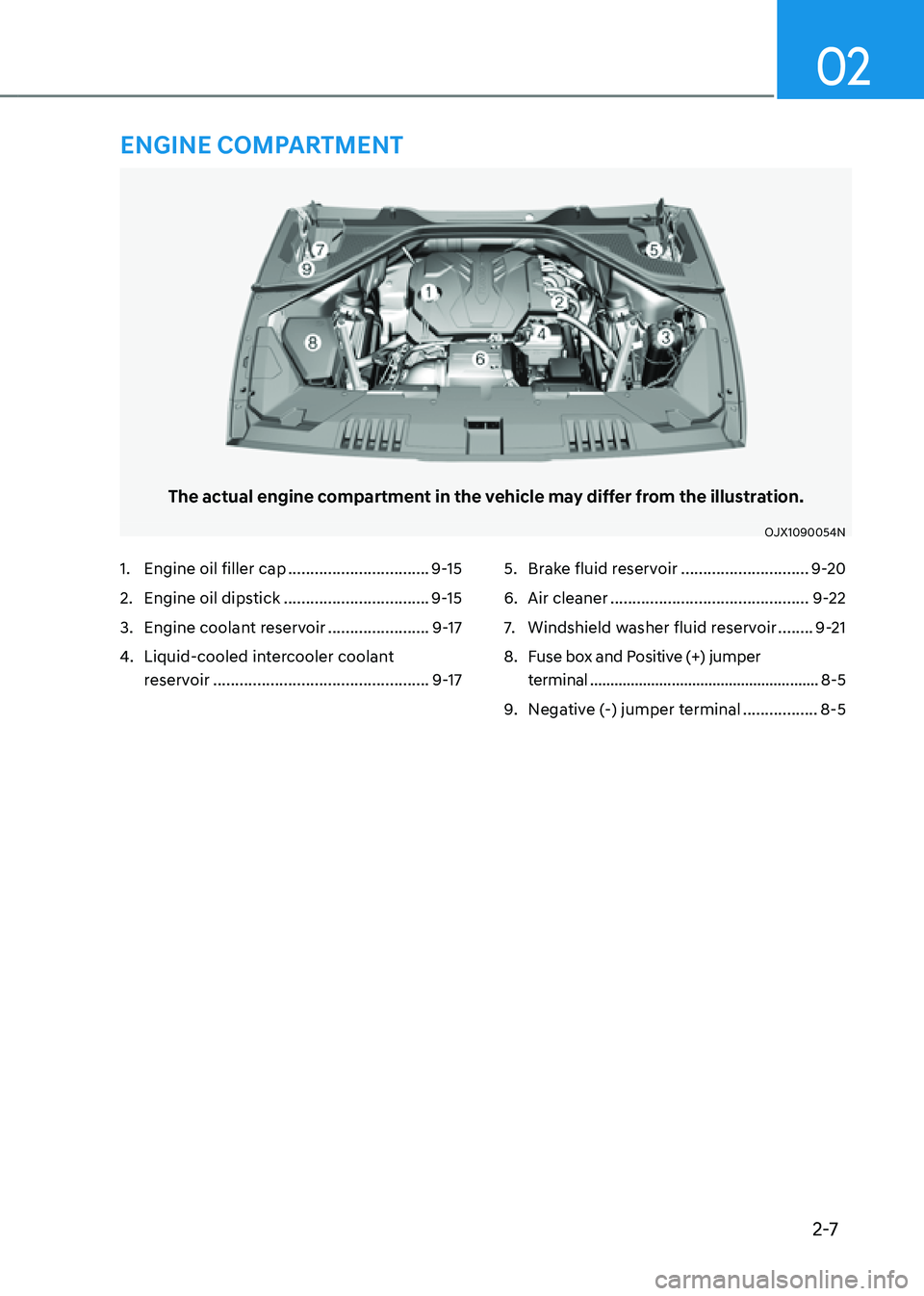
2-7
02
The actual engine compartment in the vehicle may differ from the illustration.
OJX1090054NOJX1090054N
1. Engine oil filler cap ................................9-15
2. Engine oil dipstick .................................9-15
3. Engine coolant reservoir .......................9-17
4. Liquid-cooled intercooler coolant
reservoir
.................................................9-17
5. Brake fluid reservoir .............................9-20
6. Air cleaner .............................................9-22
7. Windshield washer fluid reservoir ........9-21
8. Fuse box and Positive (+) jumper
terminal
........................................................8-5
9. Negative (-) jumper terminal .................8-5
ENGINE COMPARTMENT
Page 24 of 632

Vehicle Information, Consumer Information and Reporting Safety Defects
2-12
To help achieve proper engine and powertrain performance and durability, use only
lubricants of the proper quality. The correct lubricants also help promote engine
efficiency that results in improved fuel economy.
These lubricants and fluids are recommended for use in your vehicle.
LubricantVolumeClassification
Engine oil
*1 *2
Recommends 2.5L T-GDI 6.5 US qt.
(6.2 ℓ ) API SN PLUS /SP or ILSAC GF-6 *3
SAE : 0W-30
3.5L T-GDI7.4 US qt.
(7.0 ℓ) API SN PLUS /SP or ILSAC GF-6 *3
SAE : 0W-30
Automatic transmission fluid 9.7 US qt.
(9.2 ℓ) GS ATF SP-IV-RR, Genesis/
HYUNDAI genuine ATF SP-IV-RR
or other brands meeting the above
specification approved by Genesis
Customer Care
Engine
coolant 2.5L T-GDI
10.6 US qt.
(10.1 ℓ)
Mixture of antifreeze and water
(Phosphate-based Ethylene glycol
coolant for aluminum radiator)
15.3 US qt.
(14.5 ℓ)
3.5L T-GDI 11.6 US qt.
(11.0 ℓ)
16.3 US qt. (15.5 ℓ)
Liquid-cooled intercooler
coolant 3.9 US qt.
(3.7 ℓ)
Brake fluid
*4As required SAE J1704 DOT-4 LV, FMVSS 116 DOT-
4, ISO4925 CLASS-6
Front differential oil (AWD)
*50.71 ± 0.026 US qt. (0.67 ± 0.025 ℓ) HYPOID GEAR OIL API GL-5 SAE
75W/85
(SK HK SYN GEAR OIL 75W85 FM
PLUS OR EQUIVALENT)
Rear differential oil
*51.37 ± 0.05 US qt. (1.3 ± 0.05 ℓ) HYPOID GEAR OIL API GL-5 SAE
75W/85
(SK HK SYN GEAR OIL 75W85 OR
EQUIVALENT)
Transfer case oil (AWD) 1.11 ± 0.022 US qt.
(1.05 ± 0.021 ℓ) FUCHS ATF 134 MPT
Electronic Limited Slip
Differential (e-LSD) oil 0.433 ± 0.015 US qt.
(410 ± 15 mℓ) SHELL TF0870 C
Fuel 21.1 US gal.
(80 ℓ) Refer to “Fuel requirements” in
chapter 1.
RECOMMENDED LUBRICANTS AND CAPACITIES
Page 25 of 632
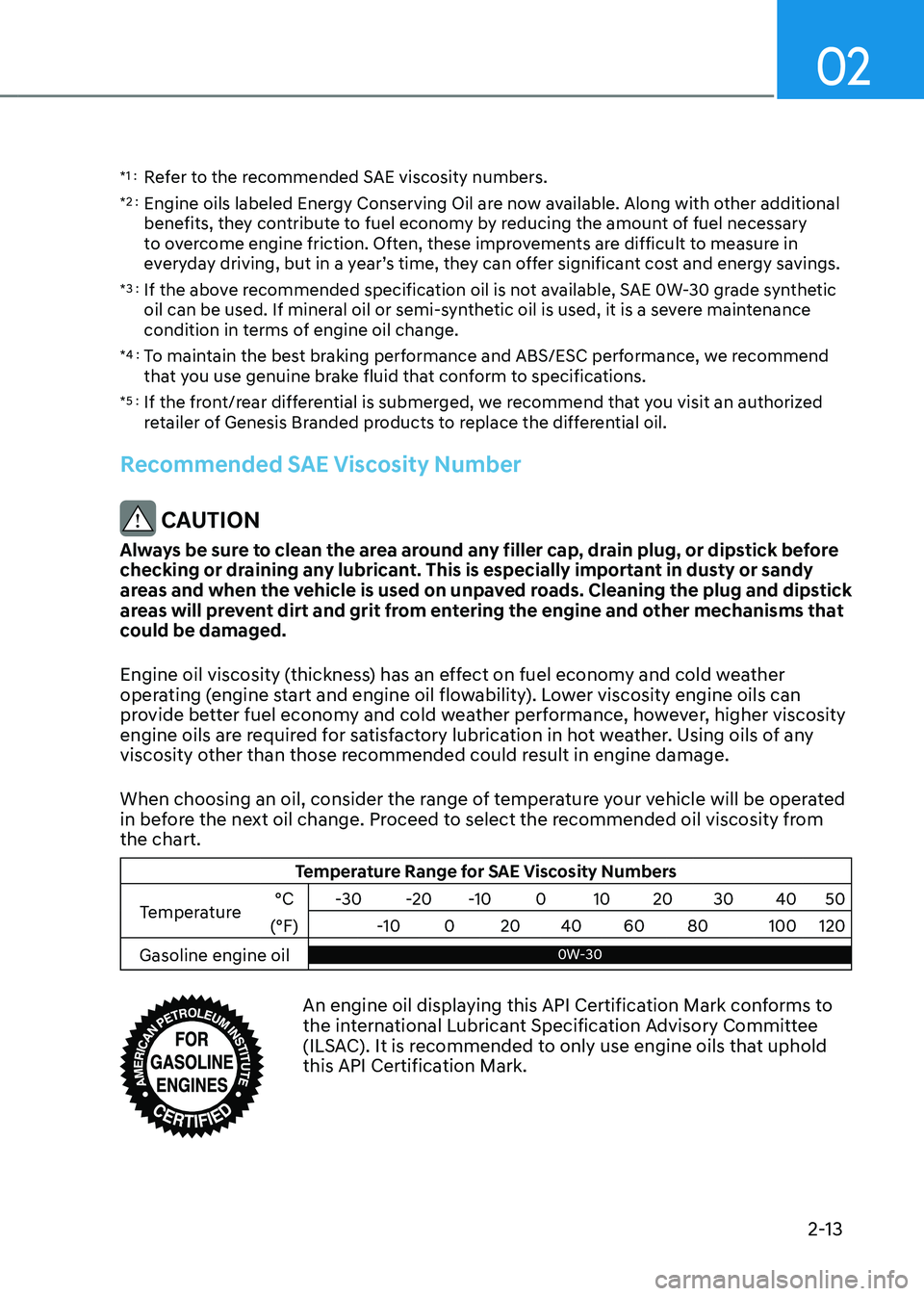
02
2-13
*1 : Refer to the recommended SAE viscosity numbers.
*2 : Engine oils labeled Energy Conserving Oil are now available. Along with other additional
benefits, they contribute to fuel economy by reducing the amount of fuel necessary
to overcome engine friction. Often, these improvements are difficult to measure in
everyday driving, but in a year’s time, they can offer significant cost and energy savings.
*3 : If the above recommended specification oil is not available, SAE 0W-30 grade synthetic
oil can be used. If mineral oil or semi-synthetic oil is used, it is a severe maintenance
condition in terms of engine oil change.
*4 : To maintain the best braking performance and ABS/ESC performance, we recommend
that you use genuine brake fluid that conform to specifications.
*5 : If the front/rear differential is submerged, we recommend that you visit an authorized
retailer of Genesis Branded products to replace the differential oil.
Recommended SAE Viscosity Number
CAUTION
Always be sure to clean the area around any filler cap, drain plug, or dipstick before
checking or draining any lubricant. This is especially important in dusty or sandy
areas and when the vehicle is used on unpaved roads. Cleaning the plug and dipstick
areas will prevent dirt and grit from entering the engine and other mechanisms that
could be damaged.
Engine oil viscosity (thickness) has an effect on fuel economy and cold weather
operating (engine start and engine oil flowability). Lower viscosity engine oils can
provide better fuel economy and cold weather performance, however, higher viscosity
engine oils are required for satisfactory lubrication in hot weather. Using oils of any
viscosity other than those recommended could result in engine damage.
When choosing an oil, consider the range of temperature your vehicle will be operated
in before the next oil change. Proceed to select the recommended oil viscosity from
the chart.
Temperature Range for SAE Viscosity Numbers
Temperature °C
-30 -20-10 010 20 30 4050
(°F) -10020 40 60 80 100120
Gasoline engine oil
0W-300W-30
An engine oil displaying this API Certification Mark conforms to the international Lubricant Specification Advisory Committee
(ILSAC). It is recommended to only use engine oils that uphold
this API Certification Mark.
Page 43 of 632
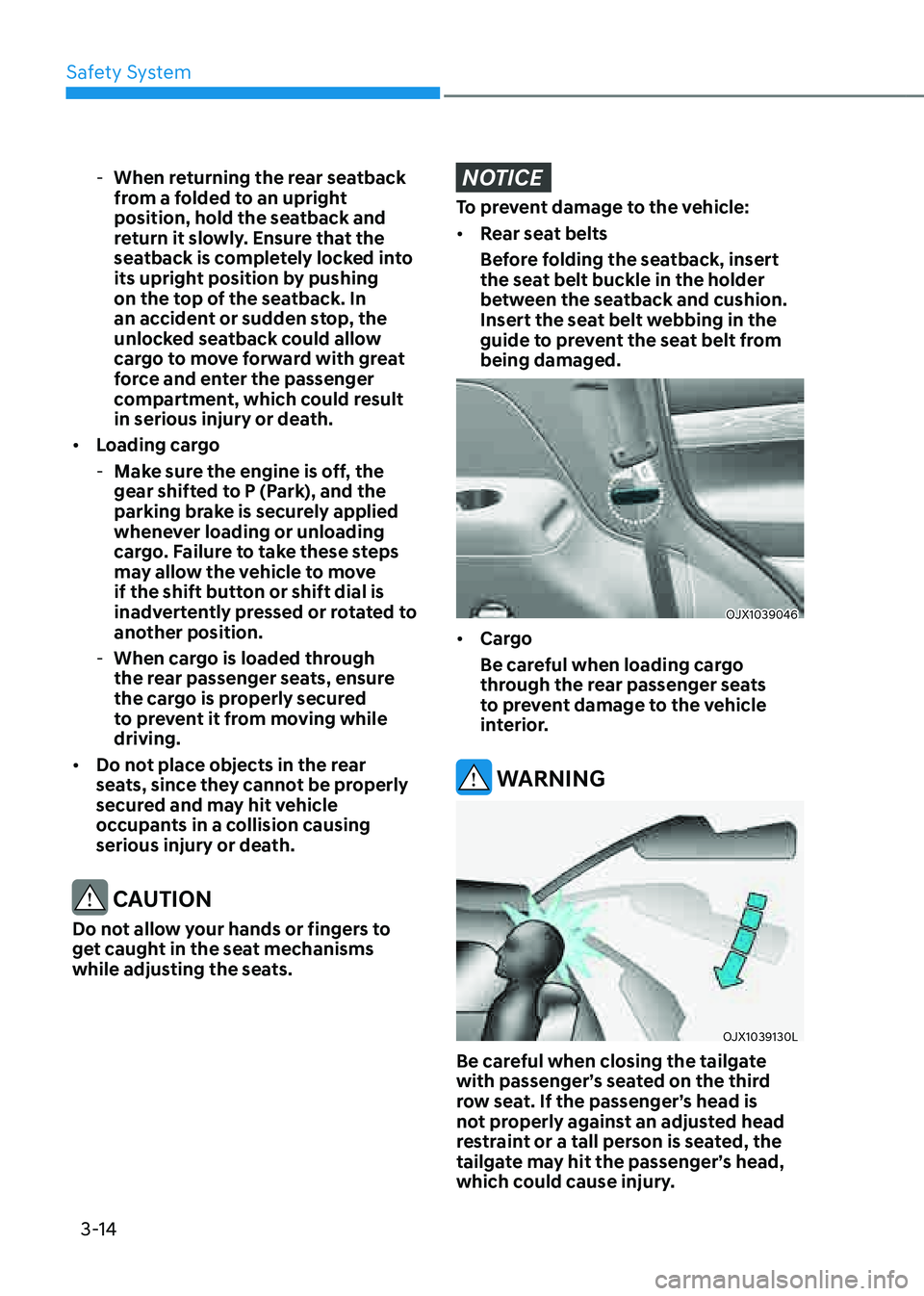
Safety System
3-14
-When returning the rear seatback
from a folded to an upright
position, hold the seatback and
return it slowly. Ensure that the
seatback is completely locked into
its upright position by pushing
on the top of the seatback. In
an accident or sudden stop, the
unlocked seatback could allow
cargo to move forward with great
force and enter the passenger
compartment, which could result
in serious injury or death.
• Loading cargo
-Make sure the engine is off, the
gear shifted to P (Park), and the
parking brake is securely applied
whenever loading or unloading
cargo. Failure to take these steps
may allow the vehicle to move
if the shift button or shift dial is
inadvertently pressed or rotated to
another position.
-When cargo is loaded through
the rear passenger seats, ensure
the cargo is properly secured
to prevent it from moving while
driving.
• Do not place objects in the rear
seats, since they cannot be properly
secured and may hit vehicle
occupants in a collision causing
serious injury or death.
CAUTION
Do not allow your hands or fingers to
get caught in the seat mechanisms
while adjusting the seats.
NOTICE
To prevent damage to the vehicle:
• Rear seat belts
Before folding the seatback, insert
the seat belt buckle in the holder
between the seatback and cushion.
Insert the seat belt webbing in the
guide to prevent the seat belt from
being damaged.
OJX1039046OJX1039046
• Cargo
Be careful when loading cargo
through the rear passenger seats
to prevent damage to the vehicle
interior.
WARNING
OJX1039130LOJX1039130L
Be careful when closing the tailgate
with passenger’s seated on the third
row seat. If the passenger’s head is
not properly against an adjusted head
restraint or a tall person is seated, the
tailgate may hit the passenger’s head,
which could cause injury.
Page 103 of 632
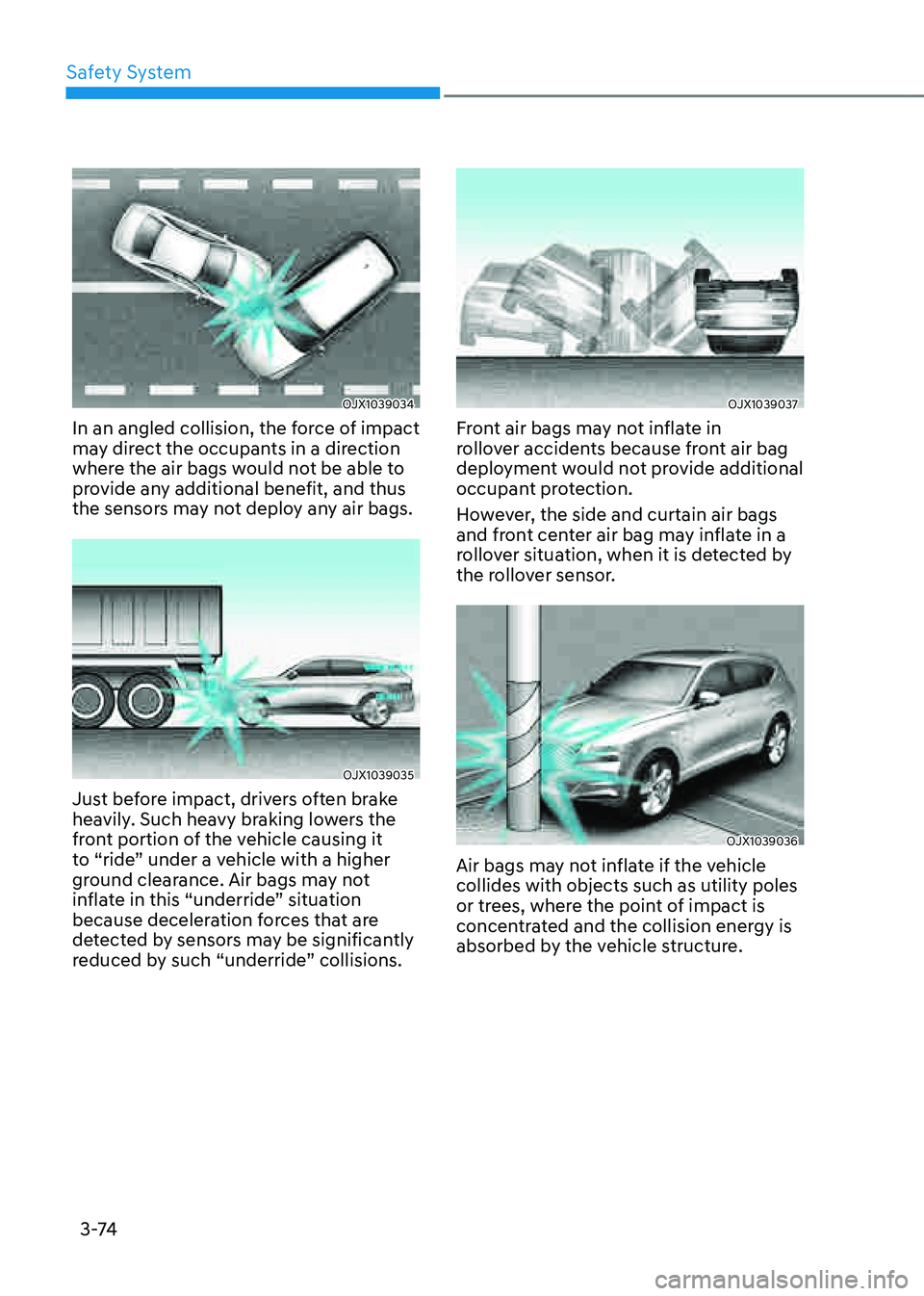
Safety System
3 -74
OJX1039034OJX1039034
In an angled collision, the force of impact
may direct the occupants in a direction
where the air bags would not be able to
provide any additional benefit, and thus
the sensors may not deploy any air bags.
OJX1039035OJX1039035
Just before impact, drivers often brake
heavily. Such heavy braking lowers the
front portion of the vehicle causing it
to “ride” under a vehicle with a higher
ground clearance. Air bags may not
inflate in this “underride” situation
because deceleration forces that are
detected by sensors may be significantly
reduced by such “underride” collisions.
OJX1039037OJX1039037
Front air bags may not inflate in
rollover accidents because front air bag
deployment would not provide additional
occupant protection.
However, the side and curtain air bags
and front center air bag may inflate in a
rollover situation, when it is detected by
the rollover sensor.
OJX1039036OJX1039036
Air bags may not inflate if the vehicle
collides with objects such as utility poles
or trees, where the point of impact is
concentrated and the collision energy is
absorbed by the vehicle structure.
Page 106 of 632
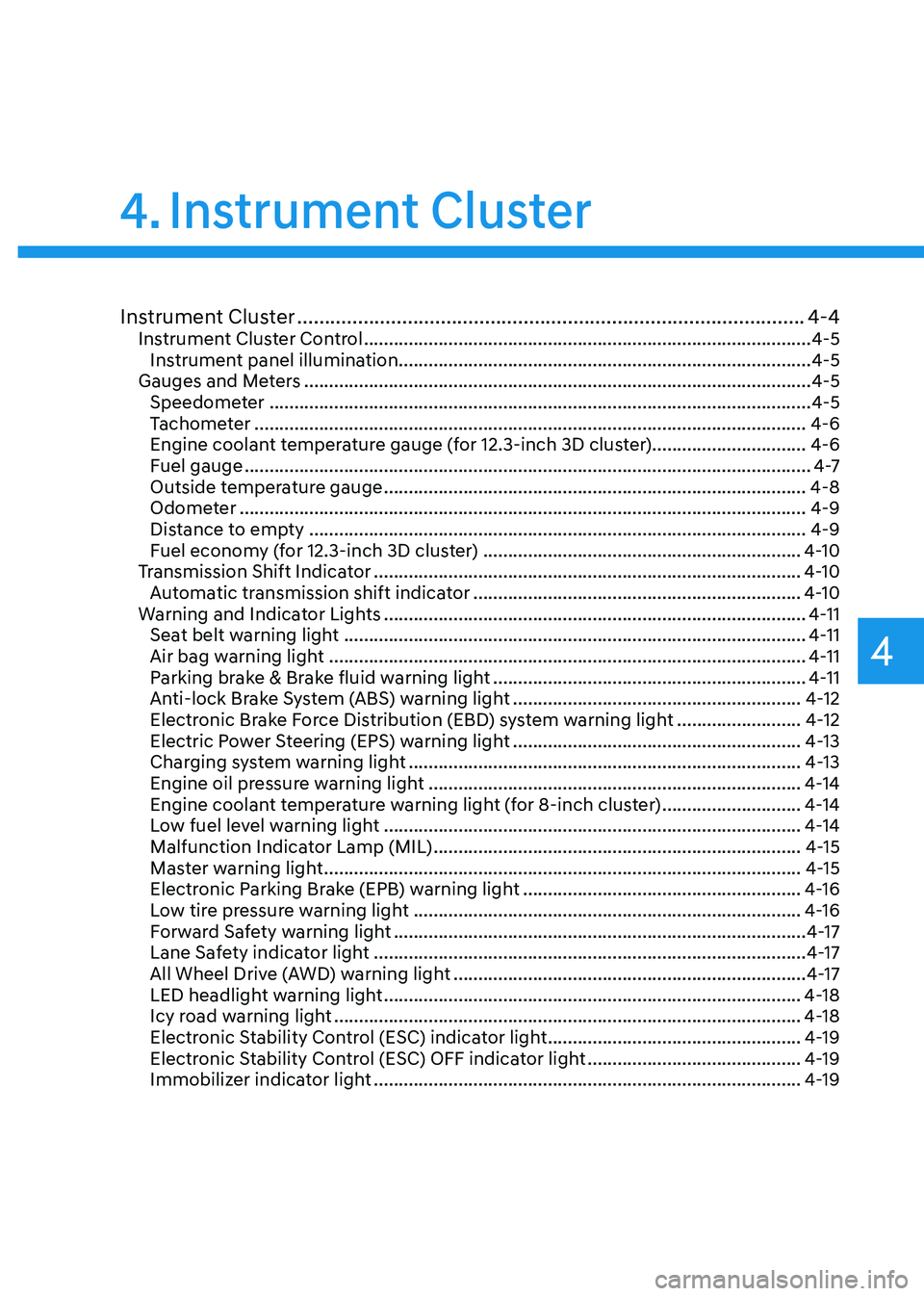
Instrument Cluster
4
Instrument Cluster ........................................................................\
....................4-4Instrument Cluster Control ........................................................................\
..................4-5
Instrument panel illumination ........................................................................\
...........4-5
Gauges and Meters ........................................................................\
..............................4-5
Speedometer ........................................................................\
.....................................4-5
Tachometer ........................................................................\
.......................................4-6
Engine coolant temperature gauge (for 12.3-inch 3D cluster) ...............................4-6
Fuel gauge
........................................................................\
..........................................4 -7
Outside temperature gauge ........................................................................\
.............4-8
Odometer ........................................................................\
..........................................4-9
Distance to empty ........................................................................\
............................4-9
Fuel economy (for 12.3-inch 3D cluster) ................................................................4-10
Transmission Shift Indicator ........................................................................\
..............4-10
Automatic transmission shift indicator ..................................................................4-10
Warning and Indicator Lights ........................................................................\
.............4-11
Seat belt warning light ........................................................................\
.....................4-11
Air bag warning light ........................................................................\
........................4-11
Parking brake & Brake fluid warning light ...............................................................4-11
Anti-lock Brake System (ABS) warning light ..........................................................4-12
Electronic Brake Force Distribution (EBD) system warning light .........................4-12
Electric Power Steering (EPS) warning light ..........................................................4-13
Charging system warning light ........................................................................\
.......4-13
Engine oil pressure warning light ........................................................................\
...4-14
Engine coolant temperature warning light (for 8-inch cluster) ............................4-14
Low fuel level warning light ........................................................................\
............4-14
Malfunction Indicator Lamp (MIL) ........................................................................\
..4-15
Master warning light ........................................................................\
........................4-15
Electronic Parking Brake (EPB) warning light ........................................................4-16
Low tire pressure warning light ........................................................................\
......4-16
Forward Safety warning light ........................................................................\
...........4-17
Lane Safety indicator light ........................................................................\
...............4-17
All Wheel Drive (AWD) warning light .......................................................................4-17
LED headlight warning light ........................................................................\
............4-18
Icy road warning light ........................................................................\
......................4-18
Electronic Stability Control (ESC) indicator light ...................................................4-19
Electronic Stability Control (ESC) OFF indicator light ...........................................4-19
Immobilizer indicator light ........................................................................\
..............4-19
4. Instrument Cluster